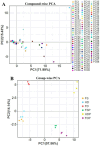Optimizing processing methods for maximum bioactive retention: comparative metabolomic analysis of dried loquat (Eriobotrya japonica) flowers and their powdered extracts
- PMID: 40823016
- PMCID: PMC12354605
- DOI: 10.3389/fnut.2025.1637247
Optimizing processing methods for maximum bioactive retention: comparative metabolomic analysis of dried loquat (Eriobotrya japonica) flowers and their powdered extracts
Abstract
Loquat (Eriobotrya japonica) flowers are a rich source of bioactive flavonoids, but their nutraceutical potential depends on post-harvest processing. This study evaluated the impact of heat-drying (HD) and freeze-drying (FD) on flavonoid retention in loquat flowers and their hot-water powdered extracts using UPLC-MS/MS metabolomics and antioxidant assays. Freeze-drying significantly preserved thermolabile compounds, with cyanidin showing a 6.62-fold increase (Log2FC 2.73) in FD compared to HD, while delphinidin 3-O-beta-D-sambubioside surged 49.85-fold (Log2FC 5.64). In contrast, heat-drying degraded many flavonoids but selectively enhanced others, such as 6-hydroxyluteolin (27.36-fold increase, Log2FC 4.77), and methyl hesperidin showed highlest percentage abundance (10.03%). Freeze-dried powder (FDP) exhibited the highest antioxidant activity (608.83 μg TE/g), linked to elevated levels of key metabolites like eriodictyol chalcone (18.62-fold increase, Log2FC 4.22). Multivariate analyses confirmed distinct clustering, with FD samples closely grouped, indicating stable metabolite preservation. Heat-dried samples showed greater variability, reflecting thermal degradation and pathway activation. The results demonstrate that freeze-drying optimizes flavonoid retention, making it ideal for high-quality nutraceuticals, while heat-drying may suit cost-effective production of select heat-stable compounds. These insights guide the development of standardized loquat flower products, balancing bioactive preservation with processing efficiency for functional food and herbal medicine applications.
Keywords: UPLC–MS/MS metabolomics; antioxidant capacity; bioactive flavonoid compound preservation; freeze-drying vs. heat-drying; loquat flower flavonoids powder.
Copyright © 2025 Duan, Feng, Feng, Wang, Xiao, He, Guo, Zhang, Jiang, Wan and Rao.
Conflict of interest statement
The authors declare that the research was conducted in the absence of any commercial or financial relationships that could be construed as a potential conflict of interest.
Figures






References
-
- Dhiman A, Suhag R, Thakur D, Gupta V, Prabhakar PK. Current status of loquat (Eriobotrya japonica Lindl.): bioactive functions, preservation approaches, and processed products. Food Rev Int. (2022) 38:286–316. doi: 10.1080/87559129.2020.1866007 - DOI
-
- Gao Y, Xia W, Shao P, Wu W, Chen H, Fang X, et al. Impact of thermal processing on dietary flavonoids. Curr Opin Food Sci. (2022) 48:100915. doi: 10.1016/j.cofs.2022.100915 - DOI
-
- ElGamal R, Song C, Rayan AM, Liu C, Al-Rejaie S, ElMasry G. Thermal degradation of bioactive compounds during drying process of horticultural and agronomic products: a comprehensive overview. Agronomy. (2023) 13:1580. doi: 10.3390/agronomy13061580 - DOI
-
- Rezvankhah A, Emam-Djomeh Z, Askari G. Encapsulation and delivery of bioactive compounds using spray and freeze-drying techniques: a review. Dry Technol. (2020) 38:235–58. doi: 10.1080/07373937.2019.1653906 - DOI
LinkOut - more resources
Full Text Sources

